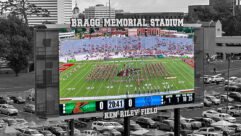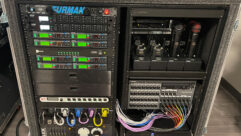
Technology Showcase: LCD Displays in Houses of Worship
Jan 1, 2007 12:00 PM,
By Jay Ankeney
New technology brings clearer images and cost savings.

Boland Communications DHD42W
High-tech media has long been a major feature in many houses of worship. The elaborate mosaics found in early Byzantine churches such as the Hagia Sophia in present-day Istanbul, Turkey (formerly Constantinople) conveyed visions of ethereal grandeur to the newly converted with gold-embossed splendor. By the 13th century, brilliant stained glass windows in European Romanesque cathedrals provided penitents with that era’s equivalent of high-definition imagery, and less than 100 years later, the audio revolution’s contribution of pipe organs added the surround sound audio of the day to the experience, complete with pew-rattling bass.
Today, there are approximately 337,000 churches and houses of worship in this country, ranging from community chapels to megachurches the size of sports stadiums, and many are adopting advanced presentation technologies to bring their message to the flock. The use of sophisticated audio systems to amplify the pastor’s words, and sometimes provide wireless communication to headphones and hearing aids, became popular during the early ’90s, for instance.
But today, visual presentation is also becoming a key component of services in larger houses of worship, as the size of such congregations expands. Modern digital projection systems are still proving the most appealing method of floating a preacher’s image at 10ft. or larger over the pulpit during services these days. After all, even a modest church can now buy a 1700-lumen projector for around $500, although regular bulb replacement can affect the usage cost of such projection systems.
LCD’S NICHE
For the very largest flatpanel displays, meanwhile, plasma technology still rules in houses of worship for presenting the largest images to mass audiences, with screens up to 103in. diagonally. As presentations grow more sophisticated, however, there are an increasing number of other needs for presenting specialized visual information to segments of the congregation at many houses of worship. For screens up to 65in., Liquid Crystal Display (LCD) technology is finding a nice niche in fulfilling this need. These days, almost all new LCD screens will be high-definition (HD) capable, but most have both high-definition and standard-definition inputs, which means they can display even a parishioner’s conventional home video images with a clarity that helps justify their cost.
According to TFCinfo, a market research and consulting firm for the audiovisual industry, 63,000 religious institutions are currently using projectors, and among them, 18 percent also have large LCD screens installed. Many more churches still have TV-style CRT monitors of one type or another installed, but they are increasingly looking to replace them with flatpanel displays. In that case, an increasingly attractive option is LCD, which ironically uses colored crystals that harken back to the original attractiveness of stained glass windows.
This trend is being driven by several factors — predominantly the plunging costs of flatpanel LCD displays in an era of rapidly disappearing CRT units. Compared to other flatpanel technologies, LCD screens also have the reputation of being less subject to burn-in when used as messaging systems, or for applications similar to what other segments of the AV installation industry refer to as digital signage.
This can be useful for scheduling announcements in reception areas, or to prompt lyrics to the choir and present Bible text to the congregation during a service. LCD displays usually weigh less than competitive plasma screens, which can be important if they are to be hung over the wings of the worship hall for “side fill” to the main display, or for ancillary purposes. And smaller LCD screens are also being increasingly installed as personal monitors in handicap pews to assist those with impaired vision.
Your house of worship clients are likely to be on a tighter budget than some of your other clients, so they might opt for less-than-professional flatpanel gear. Keep in mind some caveats when choosing or installing a large-format flatpanel display, especially if it’s consumer-oriented. First, many consumer-level, TV-style high-definition LCD screens do not include computer inputs, which are becoming useful as religious presentations are augmented by PC source material. The more inputs available on the screen the better its ability to handle current and future sources.
Second, home HDTV LCD sets may not have the glare-resistant surfaces that can minimize reflections from church windows, which are usually not equipped with shades. Third, if the display will be mounted on the floor, it would be ideal if it had hidden or “security locked” function buttons to keep inquisitive little angels from playing with its controls.
Fourth, to switch the display’s input from a central video room, it should have RS-232 serial connection ports that let other equipment interface with the screen. And finally, although a donated, older, second-hand LCD display may provide a necessary savings, the cost of replacing the bulbs behind their crystals can become a maintenance consideration after running around-the-clock, because the brightness of the LCD display dims with age. Most new LCD displays are rated for up to 60,000 hours.
One last tip: The latest trend in large-format, flatpanel, high-definition displays is 1080p, which means their picture is displayed using a progressive scan. While many consider this to be the gold standard of digital imagery, and it will keep your LCD screen current with many upcoming presentation technologies such as progressive-scan DVDs or HD-DVDs, the difference between 1080p and the more common interlaced 1080i may or may not be noticeable to your congregation. Because 1080p is the hottest new thing for upscale home theater installations, many retailers may be willing to work out attractive deals on professional-grade 1080i screens that could save on investment capital.

LG Electronics M4200N-B10
SAMPLING OF OPTIONS
Almost any LCD display can find a home in a religious institution, if only as digital signage, to relay the services to the cry room, or as entertainment in child-care nurseries. Following is a sampling of the LCD displays recommended by major domestic manufacturers for houses of worship applications.
Boland Communications recommends its DHD32W 32in.-wide LCD video monitor for use in religious institutions that would like 1366×768 resolution. The DHD32W has HD/SD SDI digital video inputs, high 500 nits brightness, a high contrast ratio of 600:1, and a wide 176°/176° viewing angle. For true 1920×1080 resolution on a 42in. screen, Boland also offers its 42in. DHD42W LCD monitor with a 178-degree viewing angle, 550 nits, and a contrast ratio of 800:1.
Home to the Envision and AOC brands, Envision Peripherals provides a comprehensive line of flatpanel displays that combine high performance and plug-and-play simplicity with low prices. The cost-efficient (less than $300) 22in. AOC 22LVWk is Mac-compatible with analog VGA Dsub or DVI port, has built-in speakers, 170°/160° viewing angles, 1680×1050 resolution at 60Hz, and DVI-D (TMDS) with high-bandwidth digital content protection (HDCP) digital input. The 22LVWk comes with a three-year warranty.
Frontniche offers LCD screens from 23in. to 57in., but the company recommends its 47in. PTP47HDSD model as optimal for house of worship installations. It features optional HD/SDI input, in case the facility needs a long-run connection to its production center. The PTP47HDSD also has advanced color temperature and gamma correction facilities, with the capability of displaying all HD formats. Frontniche LCD screens also offer Dual-Link, which provides dual 1.45Gb inputs for 2K HSDL and 10/20-bit RGB 4:4:4, and a contrast ratio of 800:1 and 600cd/m2.
JVC‘s GM-H40L2G LCD monitor is compatible with a number of signal formats, including composite or Y/C, analog RGB, and DVI-D or component video, and allows mounting in varied locations. The GM-H40L2G can talk to a variety of external control terminals, such as the common RS-232C, and even RS-485 for installations that require longer cable length. The GM-H40L2G’s IR remote sensor incorporates an Eco sensor that automatically detects ambient light and adjusts brightness to reduce excessive luminance in sanctuaries with unshielded windows. In addition, the GM-H40L2G is fully equipped with security features to lessen the chance of theft.
LG Electronics has recently introduced a 42in. LCD widescreen HDTV/network monitor, the M4200N-B10, which the company says would be ideal for houses of worship. The M4200N-B10 incorporates networking technology that allows users to view and control their network system’s settings directly from the LCD HDTV. With a built-in CPU and hard drive, the open-architecture networking controller allows easier integration and communication with the entire networked system. The display includes Super In-plane Switching (Super IPS) technology, providing fast response time and a 178-degree viewing angle for crowded rooms where a straight view isn’t available. The unit’s 1366×768 resolution, 1600:1 contrast ratio, and 500cd/m2 brightness contribute to extremely detailed and crisp images for a better overall picture.
Since the Sampo Professional brand merged with Maxent last October, its LCD screens are being marketed under the Maxent name. This includes its 42in. 1080p ML-42ULT51 LCD, which is capable of displaying two billion colors in 1920×1080 resolution. It includes MotionDSC video processing, Adaptive Motion de-interlacing, variable aspect ratio control, and generous connectivity options, including dual HDMI, HD components, S-Video/composite and computer inputs, and SPDIF digital audio optical output.
Engineered for rapid video and data response, the newest 37in. WXGA LCD monitor from Mitsubishi, the LDT371V, is optimized to display video or messaging content, making it ideal for houses of worship. A built-in scheduling utility in the LDT371V automates quick changes in the facility’s messaging, customizing its display content to be seen where and when it is needed. The unit detects if an input signal is no longer active and will automate the monitor to a Power Save state to help extend the life of the LCD panel. Mitsubishi’s 46in. MDT461S widescreen monitor has the largest display space of any Mitsubishi LCD and features an 800:1 contrast ratio, 450cd/m2 brightness, and native WXGA 1366×768 resolution. As a commercial-grade LCD panel, the MDT461S boasts increased protection against image retention and image persistence.
The 57in. NEC MultiSync LCD5710-BK supports 1080p high definition, and is optimized to be both a PC and video display, thanks to its processing chip’s advanced scaling capabilities, which include proprietary algorithms for interpolating the display of various frame rates. As the largest professional LCD available from NEC to date, the LCD5710-BK boasts NEC’s Digital Signage Technology Suite (DSTS), letting users combine multiple displays without additional hardware. The LCD5710-BK boasts more than 20 advanced features that enhance 1920×1080 display management, improve screen performance, and lower the total cost of ownership.

Panasonic TC-32LX600
The professional division of Panasonic has stopped producing large-format LCD displays, but its consumer side recommends the TC-32LX600 32in. diagonal widescreen LCD HDTV with two HDMI interfaces and 3D color management. The wide viewing angle provided by its In-Plane Switching LCD panel lets viewers enjoy an extraordinary picture from the left, right, above, or below. The Panasonic TC-32LX600 LCD display incorporates two new technologies — the Active Light Control system and Active Contrast/Gamma Control system — that adjust backlight brightness and contrast so that each scene has enhanced contrast and detail.
The wide-format WXGA 1366×768 resolution display on the BDL4221v network-controllable 42in. LCD monitor from Philips includes automatic brightness control for adjustment of display settings to correspond with ambient light without user intervention. It also features automatic overheat warning and onscreen display. Because it has RS-232 control, the BDL4221v facilitates remote management, and a VGA loop-through enables daisy chaining to multiple monitors. The local controls of the BDL4221v’s display are placed in such a way that they are less visible for immediate access. Even the remote control sensor can be disabled in order to prevent unauthorized control of the display when placed in a public space.
After Planar Systems purchased Clarity Visual Systems in September of this year, all its rear-projection products are still being called Clarity displays, but flatpanel screens are being sold under the Planar name. That means all Planar LCD displays will carry on the ambient light sensor pioneered by Clarity, which adjusts the screen’s brightness based on the surrounding light falling on the screen, thereby saving the back light’s longevity. The 46in. Clarity Bay Cat X display combines ultra-high resolution in the cutting edge of direct-view LCD technology. With a 170-degree viewing angle, the 46in. display features an anti-reflective, anti-glare glass faceplate. When coupled with Planar’s CoolSign software for digital signage, Bay Cat can be viable for wayfinding and directional signage in large houses of worship.
Samsung‘s 46in. 460PXn provides a high contrast ratio of 1200:1 and a great viewing angle of 178°/178°. It offers advanced image enhancement and features MagicNet technology, which allows users to send unique content to any MagicNet display on a network from a server. Since the embedded operating system inside Samsung’s 46in. 400PXn is Windows XP-based, its display content can be created from a USB keyboard or input from a memory stick. In addition, Samsung’s LCD displays include Multiple Display Control (MDC) software that uses RS-232C to control up to 11 monitors from a single computer.
Claimed to be the “World’s Largest Full-spec High-definition Commercial Monitor,” Sharp Electronic‘s PN-655U has a 65in. TFT LCD screen that brings images to life in a house of worship with full 1920×1080 (2-megapixel) high-definition resolution. To future-proof the investment, the PN-655U has a full complement of inputs and outputs for easy connectivity, including DVI-D, RGB analog, component video, composite video, stereo audio for PC or AV use, and RS-232C (in/out).
For more restricted budgets, Sharp upgraded its 45in. professional LCD monitor to the new PN-455RU model. The PN-455RU monitor has a full 2-megapixel, 1920×1080 HD resolution with more than six million pixel elements for exceptionally accurate and precise image reproduction. Sharp’s LCD monitor line has anti-glare and low-reflection properties, enabling Sharp monitors to be placed in areas with bright ambient light.
All of Sony‘s large-panel LCD displays, including the 40in. FWD-40LX2, incorporate WEGA Engine technology to deliver remarkable resolution and image clarity. Each of the FWD-40LX2’s inputs automatically detect the signal mode and switch to the appropriate input, eliminating the need for manual selection. Sony’s new plug-in card doesn’t even need a network to control the 40in. FWD-40LX2. Data and images can be put on a CompactFlash media card and will automatically play when the display is scheduled to turn on. Or information can be fed to each monitor individually from a playback device for growing ministries that often occupy vast complexes and need to get information out across multiple locations.
Boland Communications
www.bolandcom.com
For More Information
Envision Peripherals
www.epius.com
Frontniche
www.frontnichena.com
JVC
pro.jvc.com
LG Electronics
www.lgcommercial.com
Maxent
www.maxentusa.com
Mitsubishi
www.mitsubishi-presentations.com
Panasonic
www2.panasonic.com
Philips
www.philips.com/professional
Planar Systems
www.planarclaritydisplays.com
Samsung
www.samsung.com
Sharp
www.sharpusa.com
Sony
b2b.sony.com
Jay Ankeneyis an industry consultant and former TV network engineer living in the Los Angeles area.










